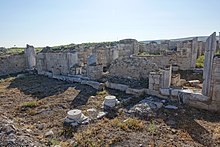Amorion
Coordinates: 39 ° 1 ′ 13.6 ″ N , 31 ° 17 ′ 20.9 ″ E

Amorion , Latin Amorium , was a Byzantine city in Phrygia near today's Hisarköy , in the Turkish province of Afyonkarahisar , twelve kilometers east of the district of Emirdağ .
Amorion was in the Byzantine period as Kastron one of the most important and heavily fortified cities of Asia Minor. In the 9th century, the city was about one kilometer in diameter, which was considerable at the time. It housed the headquarters of the theme of Anatolia (Théma tôn Anatolikôn). The city was on the road that led from Ankyra via Afyon and Dorylaeum to Iconium . In the vicinity of the city were the ancient cities of Pessinus , Germia and Vindia .
Amorion was an important Byzantine bulwark against Islamic expansion in central Anatolia . The first attacks on the city occurred around 641 and continued for the next two centuries. The city was conquered by the Arabs in 668 and recaptured by Byzantium a little later. The sieges of 716 and 796 were repelled. In 838 the city was finally conquered and destroyed under the caliph Al-Mu'tasim . Al-Mu'tasim razed the city from which the Byzantine ruler Theophilos came to avenge himself for the destruction of Zapetra ( Syria ), allegedly Al-Mu'tasim's own birthplace. Many of the residents were murdered, the rest enslaved . The Arab poet Abu Tammam wrote an ode for the conquest of Amorion. 42 nobles who had been taken hostage and preferred death to conversion to Islam were executed in Samarra ( Iraq ) in 845 and are referred to as the 42 martyrs of Amorion in the Christian doctrine of saints .
English excavations have been taking place here since 1988, initially under the direction of R. Martin Harrison , now by Chris Lightfoot.
The name of the Amorian dynasty is derived from the name of the city .
literature
- Chris S. Lightfoot: The Survival of Cities in Byzantine Anatolia, the Case of Amorium. In: Byzantion. 68, 1998, ISSN 0378-2506 , pp. 56-71.
- Margaret AV Gill (with contributions from CS Lightfoot, EA Ivison, and MT Wypyski): Amorium Reports. Volume 1: The glass. 1987-1997. Archaeopress, Oxford 2002, ISBN 1-84171-449-6 ( Amorium Monograph Series. 1 = British Archaeological Reports. International Series 1070).
- Athina Kolia-Dermitzaki: The Execution of the Forty-two Martyrs of Amorion: proposing an interpretation. In: Al-Masāq. 14, 2, 2002, ISSN 0950-3110 , pp. 141-163.
- Chris S. Lightfoot (Ed.), Amorium Reports. Volume 2: Research Papers and Technical Studies. Archaeopress, Oxford 2003, ISBN 1-84171-538-7 ( Amorium Monograph Series. 2 = British Archaeological Reports. International Series 1170).
- Chris Lightfoot, Mücahide Lightfoot: Amorium. A Byzantine city in Anatolia, an archeological guide. Homer Kitabevi, Istanbul 2007, ISBN 978-975-8293-80-3 ( Homer Archaeological Guides 5).
Web links
- Webpage of the excavation ( memento of February 20, 2015 in the Internet Archive ) (with complete bibliography)


